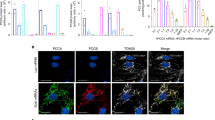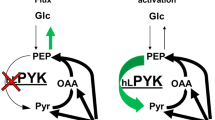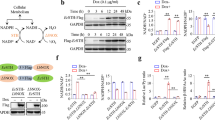Abstract
An elevated intracellular NADH:NAD+ ratio, or ‘reductive stress’, has been associated with multiple diseases, including disorders of the mitochondrial electron transport chain. As the intracellular NADH:NAD+ ratio can be in near equilibrium with the circulating lactate:pyruvate ratio, we hypothesized that reductive stress could be alleviated by oxidizing extracellular lactate to pyruvate. We engineered LOXCAT, a fusion of bacterial lactate oxidase (LOX) and catalase (CAT), which irreversibly converts lactate and oxygen to pyruvate and water. Addition of purified LOXCAT to the medium of cultured human cells with a defective electron transport chain decreased the extracellular lactate:pyruvate ratio, normalized the intracellular NADH:NAD+ ratio, upregulated glycolytic ATP production and restored cellular proliferation. In mice, tail-vein-injected LOXCAT lowered the circulating lactate:pyruvate ratio, blunted a metformin-induced rise in blood lactate:pyruvate ratio and improved NADH:NAD+ balance in the heart and brain. Our study lays the groundwork for a class of injectable therapeutic enzymes that alleviates intracellular redox imbalances by directly targeting circulating redox-coupled metabolites.
This is a preview of subscription content, access via your institution
Access options
Access Nature and 54 other Nature Portfolio journals
Get Nature+, our best-value online-access subscription
$29.99 / 30 days
cancel any time
Subscribe to this journal
Receive 12 print issues and online access
$209.00 per year
only $17.42 per issue
Buy this article
- Purchase on Springer Link
- Instant access to full article PDF
Prices may be subject to local taxes which are calculated during checkout




Similar content being viewed by others
Data availability
All data are presented in the paper and supplementary files. Supporting data will be provided upon reasonable request.
References
Vafai, S. B. & Mootha, V. K. Mitochondrial disorders as windows into an ancient organelle. Nature 491, 374–383 (2012).
Thompson Legault, J. et al. A metabolic signature of mitochondrial dysfunction revealed through a monogenic form of Leigh syndrome. Cell Rep. 13, 981–989 (2015).
Titov, D. V. et al. Complementation of mitochondrial electron transport chain by manipulation of the NAD+/NADH ratio. Science 352, 231–235 (2016).
Xiao, W. & Loscalzo, J. Metabolic responses to reductive stress. Antioxid. Redox Signal https://doi.org/10.1089/ars.2019.7803 (2019).
Gores, G. J. et al. Swelling, reductive stress, and cell death during chemical hypoxia in hepatocytes. Am. J. Physiol. 257, C347–C354 (1989).
Tilton, W. M., Seaman, C., Carriero, D. & Piomelli, S. Regulation of glycolysis in the erythrocyte: role of the lactate/pyruvate and NAD/NADH ratios. J. Lab. Clin. Med. 118, 146–152 (1991).
Williamson, J. R. et al. Hyperglycemic pseudohypoxia and diabetic complications. Diabetes 42, 801–813 (1993).
Williamson, D. H., Lund, P. & Krebs, H. A. The redox state of free nicotinamide-adenine dinucleotide in the cytoplasm and mitochondria of rat liver. Biochem. J. 103, 514–527 (1967).
Poole, R. C. & Halestrap, A. P. Transport of lactate and other monocarboxylates across mammalian plasma membranes. Am. J. Physiol. 264, C761–C782 (1993).
Shaham, O. et al. A plasma signature of human mitochondrial disease revealed through metabolic profiling of spent media from cultured muscle cells. Proc. Natl Acad. Sci. USA 107, 1571–1575 (2010).
Bucher, T. et al. State of oxidation-reduction and state of binding in the cytosolic NADH-system as disclosed by equilibration with extracellular lactate-pyruvate in hemoglobin-free perfused rat liver. Eur. J. Biochem. 27, 301–317 (1972).
Hung, Y. P., Albeck, J. G., Tantama, M. & Yellen, G. Imaging cytosolic NADH-NAD(+) redox state with a genetically encoded fluorescent biosensor. Cell Metab. 14, 545–554 (2011).
Fujii, T. et al. Efficacy of pyruvate therapy in patients with mitochondrial disease: a semi-quantitative clinical evaluation study. Mol. Genet. Metab. 112, 133–138 (2014).
Saito, K. et al. Pyruvate therapy for mitochondrial DNA depletion syndrome. Biochim. Biophys. Acta 1820, 632–636 (2012).
Li, S. J. et al. Crystallographic study on the interaction of l-lactate oxidase with pyruvate at 1.9 Angstrom resolution. Biochem. Biophys. Res. Comm. 358, 1002–1007 (2007).
Melik-Adamyan, W. et al. Substrate flow in catalases deduced from the crystal structures of active site variants of HPII from Escherichia coli. Proteins 44, 270–281 (2001).
Taurino, I. R. R. et al. Comparative study of three lactate oxidases from Aerococcus viridans for biosensing applications. Electrochim. Acta 93, 72–79 (2013).
Andre, C., Kim, S. W., Yu, X. H. & Shanklin, J. Fusing catalase to an alkane-producing enzyme maintains enzymatic activity by converting the inhibitory byproduct H2O2 to the cosubstrate O2. Proc. Natl Acad. Sci. USA 110, 3191–3196 (2013).
Martin, A., Baker, T. A. & Sauer, R. T. Rebuilt AAA+ motors reveal operating principles for ATP-fuelled machines. Nature 437, 1115–1120 (2005).
Atkinson, D. E. & Walton, G. M. Adenosine triphosphate conservation in metabolic regulation. Rat liver citrate cleavage enzyme. J. Biol. Chem. 242, 3239–3241 (1967).
De la Fuente, I. M. et al. On the dynamics of the adenylate energy system: homeorhesis vs homeostasis. PLoS ONE 9, e108676 (2014).
King, M. P. & Attardi, G. Human cells lacking mtDNA: repopulation with exogenous mitochondria by complementation. Science 246, 500–503 (1989).
Baertling, F. et al. NDUFA9 point mutations cause a variable mitochondrial complex I assembly defect. Clin. Genet. 93, 111–118 (2018).
Haut, S. et al. A deletion in the human QP-C gene causes a complex III deficiency resulting in hypoglycaemia and lactic acidosis. Hum. Genet. 113, 118–122 (2003).
Jonckheere, A. I. et al. A complex V ATP5A1 defect causes fatal neonatal mitochondrial encephalopathy. Brain 136, 1544–1554 (2013).
Johnson, S. C. et al. mTOR inhibitors may benefit kidney transplant recipients with mitochondrial diseases. Kidney Int. 95, 455–466 (2019).
Mukherjee, J. et al. Prolonged prophylactic protection from botulism with a single adenovirus treatment promoting serum expression of a VHH-based antitoxin protein. PLoS ONE 9, e106422 (2014).
Nguyen, A. et al. The pharmacokinetics of an albumin-binding Fab (AB.Fab) can be modulated as a function of affinity for albumin. Protein Eng. Des. Sel. 19, 291–297 (2006).
Gui, D. Y. et al. Environment dictates dependence on mitochondrial complex I for NAD+ and aspartate production and determines cancer cell sensitivity to metformin. Cell Metab. 24, 716–727 (2016).
Nocito, L. et al. The extracellular redox state modulates mitochondrial function, gluconeogenesis, and glycogen synthesis in murine hepatocytes. PLoS ONE 10, e0122818 (2015).
Ramirez, A. et al. Extracellular cysteine/cystine redox potential controls lung fibroblast proliferation and matrix expression through upregulation of transforming growth factor-β. Am. J. Physiol. Lung Cell. Mol. Physiol. 293, L972–L981 (2007).
Muller, H. J. & Boos, J. Use of l-asparaginase in childhood ALL. Crit. Rev. Oncol. Hematol. 28, 97–113 (1998).
Laffel, G. L. & Braunwald, E. Thrombolytic therapy. A new strategy for the treatment of acute myocardial infarction (2). N. Engl. J. Med. 311, 770–776 (1984).
Arroyo, J. D. et al. A genome-wide CRISPR death screen identifies genes essential for oxidative phosphorylation. Cell Metab. 24, 875–885 (2016).
Acknowledgements
We thank O. Goldberger, K.J. Kamer and J.D. Arroyo for technical assistance. This work was supported in part by grants from the Marriott Foundation and the National Institutes of Health (R35GM122455). A.P. was supported by the Helen Hay Whitney Postdoctoral Fellowship and the Tosteson and Fund for Medical Discovery award. O.S.S. was supported by a F32 Fellowship from the National Institute of General Medical Sciences (1F32GM133047-01). V.K.M. is an investigator of the Howard Hughes Medical Institute.
Author information
Authors and Affiliations
Contributions
A.P., X.R.B. and V.K.M. designed the study. A.P. performed and analyzed the biochemical and cell culture experiments. A.P., O.S., H.S. and R.S. performed and analyzed the LC–MS experiments. A.P., Y.M., G.S., E.M. and R.P.G. performed the mouse experiments and analyzed data. T.-L.T assisted with the K562 KO cellular experiments. F.I. and W.Z. supervised mouse studies. V.K.M. supervised the study. A.P. and V.K.M. wrote the manuscript.
Corresponding author
Ethics declarations
Competing interests
Massachusetts General Hospital has filed a patent on the technology described in this paper listing V.K.M., A.P. and X.R.B as inventors. O.S.S. is a paid consultant for Proteinaceous Inc. V.K.M. is a paid advisor to Janssen Pharmaceuticals and 5AM Ventures and is a founder of Raze Therapeutics.
Additional information
Publisher’s note Springer Nature remains neutral with regard to jurisdictional claims in published maps and institutional affiliations.
Integrated supplementary information
Supplementary Figure 1 Effect of media supplemented with lactate oxidase (LOX), catalase (CAT), or both, on the growth of cells with electron transport chain dysfunction.
Growth curve for HeLa cells treated with antimycin A in the presence of LOX, CAT, a combination of LOX and CAT, or pyruvate. Data are mean ± S.D., n = 4 total wells from three biologically independent experiments.
Supplementary Figure 2 SDS-PAGE gels of purified LOXCAT, LOXCATmut, ABP-LOXCAT, and ABP-LOXCATmut.
SDS-PAGE gels of purified (a) LOXCAT and LOXCATmut, and (b) ABP-LOXCAT and ABP-LOXCATmut. The predicted molecular weight of these proteins is ~132 kDa. The data shown are representative of at least two gels from independent protein preparations with similar results.
Supplementary Figure 3 Oxygen consumption by LOX, LOXCAT, and LOXCATmut.
Representative measurements of oxygen consumption by LOX, LOXCAT, and LOXCATmut with lactate as a substrate. The bump in the LOX curve after catalase addition represents a temporary increase in the O2 concentrations due to H2O2 breakdown by catalase. Repeated in n = 2 biologically independent experiments with similar results.
Supplementary Figure 4 Effect of extracellular LOXCAT on the intracellular NADH/NAD+ ratio measured by LCMS.
Effect of media supplemented with LOXCAT, LOXCATmut, or pyruvate on the total cellular NADH/NAD+ ratios measured by LCMS in HeLa cells treated with antimycin A for 24 h. Data are mean ± S.D., n = 6 total wells from 3 biologically independent experiments. One-way ANOVA followed by Tukey’s multiple comparisons test. ns, P = 0.99; and ****P < 0.0001.
Supplementary Figure 5 Effect of extracellular LOXCAT on media lactate and pyruvate.
Effect of extracellular LOXCAT, LOXCATmut, and pyruvate on the media levels of (a) lactate and (b) pyruvate in control, or antimycin A-treated HeLa cells at 24 h. Data are mean ± S.D., n = 16 total wells in antimycin-only treatment, n = 12 total wells in untreated and antimycin + pyruvate treatments, and n=10 total wells in antimycin + LOXCAT and antimycin + LOXCATmut treatments from 5 biologically independent experiments. One-way ANOVA followed by Tukey’s multiple comparisons test. ns, P > 0.99; and P = 0.079; ***P = 0.0001 and 0.0006; and ****P < 0.0001.
Supplementary Figure 6 Effect of LOXCAT on glycolytic intermediates in antimycin A-treated HeLa cells.
Effect of media pyruvate, LOXCAT, or LOXCATmut on glycolytic intermediates in antimycin-treated HeLa cells at 24h. Data are mean ± S.D., n = 6 total wells from 3 biologically independent experiments. One-way ANOVA followed by Tukey’s multiple comparisons test. ns, P = 0.99; **P = 0.0018, 0.0013, and 0.0027; ***P = 0.0001; and ****P < 0.0001.
Supplementary Figure 7 Morphology of antimycin A-treated HeLa cells with pyruvate, LOXCAT, or LOXCATmut.
Images of HeLa cells after 72h treatment with antimycin A with media containing pyruvate, LOXCAT or LOXCATmut. Shown are representative images of three biologically independent experiments with similar results.
Supplementary Figure 8 Effect of extracellular LOXCAT on the proliferation of cells with electron transport chain (ETC) deficiency.
Effect of extracellular LOXCAT on the proliferation of (a) HeLa cells treated with piericidin A or oligomycin A, (b) K562 UQCRB KO cells, and (c) K562 ATP5A1 KO cells at 72 h. Data are mean ± S.D., n = 6 total wells from 3 biologically independent experiments. One-way ANOVA followed by Tukey’s multiple comparisons test. ns, P = 0.98, > 0.99 and 0.83; ***P = 0.0002, 0.0001, and 0.0001; and ****P < 0.0001.
Supplementary Figure 9 Effect of blood LOXCAT on the circulating [lactate]/[pyruvate] ratio in vivo.
Effect of intravenous LOXCAT on the circulating [lactate]/[pyruvate] ratios in wild-type C57BL/6J mice at 15 min. Data are mean ± S.D., n = 3 mice per treatment. Molar ratios of lactate and pyruvate are shown. One-way ANOVA followed by Tukey’s multiple comparisons test. ns, P = 0.14; ***P = 0.001 and 0.0002.
Supplementary Figure 10 Pharmacokinetics and pharmacodynamics of ABP-LOXCAT.
(a) Circulatory half-life of LOXCAT vs ABP-LOXCAT in wild-type C57BL/6J mice measured by western blot (data shown are representative of 2 blots from two mice with similar results) (b) Enzyme activity of ABP-LOXCAT vs ABP-LOXCATmut over 300 minutes in the circulation of wild-type C57BL/6J mice. Absolute concentrations of lactate and pyruvate were measured using LCMS. Data are mean ± S.D., n = 3 mice per timepoint. Two-way ANOVA followed by Sidak multiple comparisons test. ns, P = 0.59 and 0.99; **P = 0.0016 and 0.0079; and ****P < 0.0001.
Supplementary Figure 11 Full scans of all gels and blots used in the manuscript.
(a) Coomassie-stained SDS-PAGE gel of purified LOXCAT and LOXCATmut. (b) Coomassie-stained SDS-PAGE gel of purified ABP-LOXCAT and ABP-LOXCATmut. (c) Western blot detection of LOXCAT (anti-S-tag) from whole blood. (d) Western blot detection of mouse serum albumin (anti-albumin) from whole blood as loading control for LOXCAT. (e) Western blot detection of ABP-LOXCAT (anti-S-tag) from whole blood. (f) Western blot detection of mouse serum albumin (anti-albumin) from whole blood as loading control for ABP-LOXCAT. (g) Western blot detection of ATP5A1 (anti-ATP5A1) in K562 KO cells. (h) Western blot detection of actin (anti-actin) in K562 ATP5A1 KO cells. (i) Western blot detection of UQCRB (anti-UQCRB) in K562 KO cells. (j) Western blot detection of actin (anti-actin) in K562 UQCRB KO cells. All data shown are representative of two independent blots and at least two independent gels with similar results.
Supplementary Figure 12 Ability of LOXCAT and LOXCATmut to consume H2O2.
H2O2 measurements after (a) lactate and (b) H2O2 incubation with ABP-LOXCAT or ABP-LOXCATmut. Data are mean ± S.D., n = 4 biologically independent samples in panel (a) and n = 3 biologically independent samples in panel (b). One-way ANOVA followed by Tukey’s multiple comparisons test. **P = 0.0076 and 0.0077; and ****P < 0.0001.
Supplementary Figure 13 Effect of extracellular pyruvate, ABP-LOXCAT, or ABP-LOXCATmut on the proliferation of antimycin A-treated HeLa cells.
Effect of media supplemented with ABP-LOXCAT, ABP-LOXCATmut, and pyruvate on proliferative defects in HeLa cells treated with antimycin A at 72h. Data are mean ± S.D., n = 6 total wells from 3 biologically independent experiments. One-way ANOVA followed by Tukey’s multiple comparisons test. ns, P = 0.99; and ****P < 0.0001.
Supplementary Figure 14 Effect of intravenous ABP-LOXCAT on tissue [NADH], [NAD+], and [NADH]/[NAD+] in metformin-treated mice.
Effect of circulating ABP-LOXCAT on (a) brain [NADH], (b) brain [NAD+], (c) heart [NADH], (d) heart [NAD+], (e) liver [NADH]/[NAD+] ratio, and (f) kidney [NADH]/[NAD+] ratio in metformin-treated mice. Molar ratios of NADH and NAD+ are shown. Data are mean ± S.D., n = 13 mice. One-way ANOVA followed by Tukey’s multiple comparisons test. ns, P = 0.82, 0.15, 0.17, 0.90, 0.47, 0.50, 0.99, 0.91, 0.97, 0.99, 0.23, 0.16, 0.083, 0.86, 0.69, 0.053, 0.98, 0.99; *P = 0.015; ***P = 0.0001, 0.0002 ; and ****P < 0.0001.
Supplementary Figure 15 Western blots for validation of K562 UQCRB KO and ATP5A1 KO cells.
Validation of K562 UQCRB KO and ATP5A1 KO cell lines by western blots with the following antibodies: anti-UQCRB (Abcam ab190360), anti-ATP5A1 (Abcam ab110411), and anti-β-Actin (A5441 Sigma). Shown are representative blots from two independent experiments with similar results.
Supplementary information
Rights and permissions
About this article
Cite this article
Patgiri, A., Skinner, O.S., Miyazaki, Y. et al. An engineered enzyme that targets circulating lactate to alleviate intracellular NADH:NAD+ imbalance. Nat Biotechnol 38, 309–313 (2020). https://doi.org/10.1038/s41587-019-0377-7
Received:
Accepted:
Published:
Issue Date:
DOI: https://doi.org/10.1038/s41587-019-0377-7
This article is cited by
-
Lactate oxidase/catalase-displaying nanoparticles efficiently consume lactate in the tumor microenvironment to effectively suppress tumor growth
Journal of Nanobiotechnology (2023)
-
Functional heterogeneity of MCT1 and MCT4 in metabolic reprogramming affects osteosarcoma growth and metastasis
Journal of Orthopaedic Surgery and Research (2023)
-
Loss of microglial MCT4 leads to defective synaptic pruning and anxiety-like behavior in mice
Nature Communications (2023)
-
Coenzyme self-sufficiency system-recent advances in microbial production of high-value chemical phenyllactic acid
World Journal of Microbiology and Biotechnology (2023)
-
Molecular imaging: design mechanism and bioapplications
Science China Chemistry (2023)



